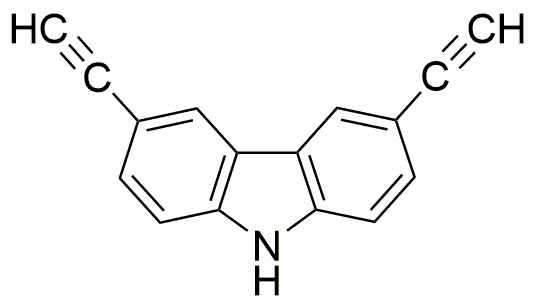3,6-Diethynylcarbazole is widely utilized in research focused on:
- Organic Electronics: This compound is used in the development of organic light-emitting diodes (OLEDs) and organic photovoltaics (OPVs), enhancing device efficiency and stability.
- Polymer Chemistry: It serves as a building block in synthesizing advanced polymers, contributing to materials with improved mechanical and thermal properties.
- Fluorescent Probes: Researchers employ it in creating fluorescent probes for biological imaging, allowing for better visualization of cellular processes.
- Photovoltaic Applications: Its unique structure aids in the design of new materials for solar cells, potentially increasing energy conversion efficiency compared to traditional compounds.
- Sensor Technology: The compound is also explored in sensor applications, where its properties can be harnessed for detecting environmental pollutants or biological markers.
General Information
Properties
Safety and Regulations
Applications
3,6-Diethynylcarbazole is widely utilized in research focused on:
- Organic Electronics: This compound is used in the development of organic light-emitting diodes (OLEDs) and organic photovoltaics (OPVs), enhancing device efficiency and stability.
- Polymer Chemistry: It serves as a building block in synthesizing advanced polymers, contributing to materials with improved mechanical and thermal properties.
- Fluorescent Probes: Researchers employ it in creating fluorescent probes for biological imaging, allowing for better visualization of cellular processes.
- Photovoltaic Applications: Its unique structure aids in the design of new materials for solar cells, potentially increasing energy conversion efficiency compared to traditional compounds.
- Sensor Technology: The compound is also explored in sensor applications, where its properties can be harnessed for detecting environmental pollutants or biological markers.
Documents
Safety Data Sheets (SDS)
The SDS provides comprehensive safety information on handling, storage, and disposal of the product.
Product Specification (PS)
The PS provides a comprehensive breakdown of the product’s properties, including chemical composition, physical state, purity, and storage requirements. It also details acceptable quality ranges and the product's intended applications.
Certificates of Analysis (COA)
Search for Certificates of Analysis (COA) by entering the products Lot Number. Lot and Batch Numbers can be found on a product’s label following the words ‘Lot’ or ‘Batch’.
Número de catálogo
Número de lote/lote
Certificates Of Origin (COO)
This COO confirms the country where the product was manufactured, and also details the materials and components used in it and whether it is derived from natural, synthetic, or other specific sources. This certificate may be required for customs, trade, and regulatory compliance.
Número de catálogo
Número de lote/lote
Safety Data Sheets (SDS)
The SDS provides comprehensive safety information on handling, storage, and disposal of the product.
DownloadProduct Specification (PS)
The PS provides a comprehensive breakdown of the product’s properties, including chemical composition, physical state, purity, and storage requirements. It also details acceptable quality ranges and the product's intended applications.
DownloadCertificates of Analysis (COA)
Search for Certificates of Analysis (COA) by entering the products Lot Number. Lot and Batch Numbers can be found on a product’s label following the words ‘Lot’ or ‘Batch’.
Número de catálogo
Número de lote/lote
Certificates Of Origin (COO)
This COO confirms the country where the product was manufactured, and also details the materials and components used in it and whether it is derived from natural, synthetic, or other specific sources. This certificate may be required for customs, trade, and regulatory compliance.


